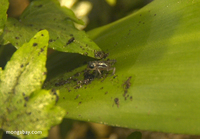|
| Query: toad | Result: 35th of 644 | |
Baby Kihansi Spray Toads in captivity. Young toadlets are purple in color, while adults are yellow.

| Resolution: 600x417
File Size: 174427 Bytes
Upload Date: 2008:02:28 22:01:08
|
Baby Kihansi Spray Toads in captivity. Young toadlets are purple in color, while adults are yellow.
Toad on brink of extinction, scientists race to study amphibian for bioactive compounds
and has pledged another $60,000. This money ultimately comes from the World Bank which is now paying for the ecological damage created by the dam which currently supplies 25 percent of the country�s power demand and generates $63 million a year in revenue.
With this sad fate in prospect, many groups have been quick to lay blame on various parties for the toad�s seemingly unavoidable demise as well as the general mismanagement of a fragile ecosystem. The International Rivers Network (IRN) accuses the World Bank of negligence in failing to require a thorough Environmental Impact Assessment (EIA) before it financed the hydroelectric project. The IRN notes that the bank also neglected to modify the project design, implementation and operation after the environmental impacts became more clearly apparent as the gorge's endemic
species were discovered in December 1996. Construction continued on uninterrupted after the discovery and the Tanzania Electricity Supply Company was not informed of these discoveries until 1998. This critical omission violated Bank policies and betrayed their commitments under the International Convention on Biological Diversity.
Baby Kihansi Spray Toads in captivity. Young toadlets are purple in color, while adults are yellow.
Whatever the fate of the Kihansi Spray Toad and its irrevocably altered gorge habitat, this story is one that scientists have heard before and are likely to hear again. This outcome is indicative of a much larger and very grave trend in amphibian species on a global level. Because amphibians are particularly susceptible to disturbances in the habitats, they continue to disappear in disproportionate numbers. Nearly one third of the world�s amphibian species are threatened and almost half are in decline. Since 1980, more than 100 of these animal species have gone missing and are assumed to be extinct. If the Kihansi Spray joins the ranks of these fallen species, will people start listening?
|
^o^
Animal Pictures Archive for smart phones
^o^
|
|